So it was with great sadness that I left the beautiful old town of Ohrid and my magnificent views of the lake. Today we would be traveling east, but instead of taking the main road, Jane suggested that we take the slower route that would have us traveling parallel to Lake Ohrid before climbing into the mountains. The route also gave me the opportunity to see another fresh water lake, Lake Prespa, that is seldom visited and has virtually no tourism. Fine by me.

We left Ohrid just after 8:00 a.m. and were soon driving parallel to Lake Ohrid on a very narrow, seldom traveled road. It wasn’t long before we were entering the National Park of Galicica and driving on a very windy road that took us on a series of switchbacks, up, up, up, the mountainside. When we reached the highest peak on the road, we were directly above the little village of Trpejca, where we had that fabulous lunch yesterday.
Dean stopped the car at the summit, and we took a look at the magnificent views over Lake Ohrid where we could make out the St. Naum Monestary and of course, the coast line of Albania. The air was rather cool (we were at around 4,000 feet), but fortunately the sun was shining so it made for some really spectacular pictures.
Once over the crest of the mountain, Prespa Lake came into view. Unfortunately, there was some fog-like conditions over the lake so the views, while nice, were subpar compared to the views of Lake Ohrid.
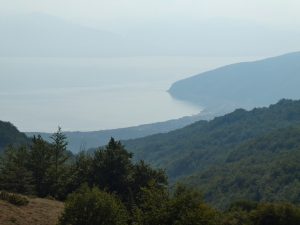
We began the drive on the other side of the mountain through the forest on a series of switchbacks. It was not long before we reached the bottom and were turning into the one and only resort in the area for some morning coffee (or in my case tea).
Now while the resort building appeared rather nice on the exterior, the grounds needed some serious landscaping work. Small round tables and chairs were propped up on the very dead brown grass and the little marigold plants that you would typically find in someone’s home garden looked out of place and minuscule compared to the massive grounds. And the “beach” was filled with mud in front of grey sand that had apparently been trucked in.
The place also looked deserted. In fact, besides the waiter, we only saw three people while we were there. Apparently the owners are Americans with Macedonian roots and sold everything to open the resort. It appeared to me that they place could use an infusion of substantial funds to make the grounds look professional.
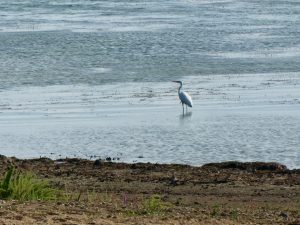
Now the upside was that the tea was good and I got to enjoy a heron holding court in the waters near where we were seated. However, the place still appeared very sad in comparison to the incredible resorts and seaside activities at Lake Ohrid.
Once I was finished my tea, we set out for the town of Bitola where we would be visiting the ancient city of Heraclea Lyncestis, about two kilometers from town. Now Heraclea Lyncestis was founded in the 4th century B.C. by Philip the Macedon and remained a strategic location for hundreds of years. In 146 B.C., the Romans conquered Macedonia annexing it as province of Rome. Despite its loss in status, Heraclea continued to prosper because of its location on the Via Egnatia road, an important trading route.
After the Roman Empire crumbled, Heraclea Lyncestis became an important Christian center and the site is apparently mentioned in numerous church teachings.
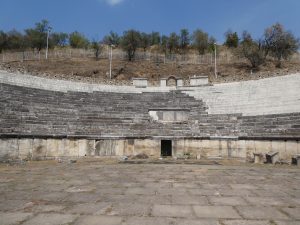
Now I was beside myself with excitement about visiting Heraclea Lyncestis. If you know me, I love, love, love hiking around old ruins. And fortunately for me, Heraclea Lyncestis did not disappoint.
When we arrived, a tour group from Poland had just started their visit, so Jane and I decided to visit the site backwards so we started by hiking the stone stairs to the the massive Roman theatre, which contained substantial repairs to the seating. The theatre was high above the remaining ruins, which by the way are only 20% uncovered, and gave us a great vantage point above the site.

After wandering around the theatre we took a path that brought us closer to the ruins but still had us looking down onto the site. And as it turned out this was prime viewing for looking at the giant mosaic tile floors that were found in the “Episcopal Residence” and the “Small Basilica”.



We climbed down still more rocks and wandered around the Episcopal Residence to take in the gorgeous tile mosaics. We then walked through the weeds (the site is not what I would describe as well maintained) to the Great Basilica and the City Fountain before doubling back to see the Portoco of the Courtroom. On the grass opposite the Portoco was a statute of Nemesis – goddess of justice and fate. Unfortunately, she had no head. (I am sure there are a lot of lawyer haters out there who probably see that as fitting.)
Anyway, we ended the visit by checking out the Thermal Baths, the Small Basilica and the Street with Sewer System. That’s right, a sewer system. The Romans were highly advanced when it came to matters of water and sewer and the ceramic pipes that were visible throughout the grounds was a clear testament to the Romans’ ingenuity.

Once Jane finally dragged me out of the fabulous site, we drove back to the center of Bitola. On the drive, a discussion ensued about the timing for lunch. I told the guys I could eat whenever, so they should just tell me what time they thought they would be hungry to which Dean replied “we are Macedonians … we are always hungry.” And this in and of itself explains so much about this country and its obsession with food.
Anyway, we decided on 1:30 – 2:0o p.m. for lunch and with that Jane and I began a walk of Bitola’s famous Širok Sokak aka pedestrian promenade filled with shops and ended cafes. (There is a reason a giant coffee cup greets you when you enter Bitola.)
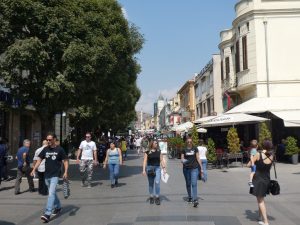
It was rather hot as we walked so we took a quick “coffee” break in the middle of our walk at what is billed as the oldest café in Bitola, the Pajit On. I ended up with tea while Jane had some fancy coffee drink. And of course this being Macedonia, we had to have a sweet so tiaramisu was also ordered, which Jane thankfully ate after I took a couple bites.


After the coffee break, we continued on the black and white tiled walkway past more shops and cafes, an event hall, and Sacred Heart of Jesus Catholic Church before finally ending up near the Bitola Clock Tower, which sits in the middle of a little park. The Clock Tower was built of stone in the mid 17th century and has undergone mechanical renovations, but little else. Apparently the tower plays random songs from a set of six songs, but we missed the last play of the day at noon (although we did hear the chimes at 1:00).
We crossed the street and took a quick look at the church of St. Dimitrija, an Orthodox Church built in the 17th century before crossing the bridge across the Dragor River and taking a little walk through the old Turkish bazaar of Bitola.

Now the bazaar is not what I am used to seeing in Muslim countries where the bazaar is filled with handicrafts, carpets, jewelers, tailors and the like. No, this bazaar was more for the everyday person and was filled with clothing shops, the occasional pharmacy, some restaurants and shoe stores. Yes I did see the odd tailor, but the bazaar lacked the atmosphere of other bazaars I have visited.

At the end of the bazaar was the green market, which was another story. The market was filled stalls and vendors selling apples, peppers, spices, massive cabbage and tomatoes along with an array of other produce that is coming to market during the harvest season.
By now, it was lunch time (yes it was close to 2:00 p.m., and they eat lunch very late here), so we tracked down Dean and headed out of Bitola over a very narrow road to the little village of Dihovo where yet another of Jane’s many friends was hosting us for lunch.

The drive was quick and before you knew it, we were being greeted by “Bale”, his father and mother at their home, which featured beautiful garden and courtyard portico covered in grapes. The family has just started hosting lunches for tourists and there is a plan to build a small guest house to host the many hikers who trek through Dihovo. For now, however, the family continue to run a number of bee hives from which they draw honey to make their many honey products.

Within a few minutes of arriving and taking a seat in their lovely outdoor dining room, we were being served an array of breads, cheeses, veggies, peppers, snails and of course the ever present pundyar (the tomato spread). The meze spread was fantastic and the raspberry/blackberry drink really quenched my thirst.

The meze spread was followed by four main courses (yes you read that right) consisting of stuffed peppers, pork and cabbage, pork with red sauce and of course a veggie dish. In addition, I was provided a glass of their home made wine which was actually quite good.
The lunch was really superb and certainly nothing you could ever purchase in a restaurant. And just when we thought we were done, Bale brought out two jars of honey for me to taste (and one of which I took home with me) and his mother brought out cake she insisted we eat. (And of course the cake was off the charts tasty.)
I could barely move by the time we were done. Thankfully we had already walked over 12,000 steps today with another projected 10,000 to come so at least I am trying to burn the calories consumed at these mammoth lunches.

We said our goodbyes and began the half hour drive to the little town of Prilep. Prilep is located in an agricultural basin (along its Bitola). However, its primary crop is not food, but tobacco. Yep. This region is the North Carolina of Macedonia, (although most of the area looks very dry and arid with little green spaces). And while smoking has declined drastically in North America, the smoking habit is alive and well in Macedonia. It seems virtually everyone smokes. It really is the only downside I have found to this country.
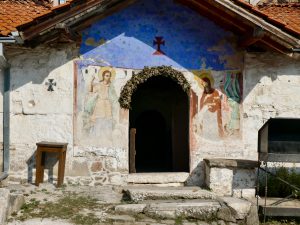
Anyway, after the very short drive to Prilep, we drove another 8 kilometers out of the city and up, up, up to the hills overlooking Prilep and the “under construction” Monastery Treskavec. Apparently the monastery suffered a devastating fire in 2010 and is only now being reconstructed.
Jane told me that the monastery was originally constructed in the 12th century, was rebuilt in the 14th century and renovated in the 16th century. Now while the fire destroyed most of the monastery, the church was miraculously saved and thankfully so because the church houses a large collection of Byzantine frescoes with some dating to the 15th century.
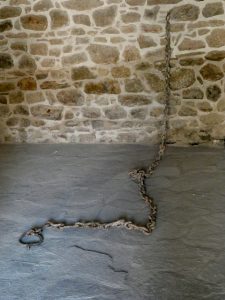
Anyway, our visit had us hopping over lumber and avoiding scaffolding, but nevertheless the visit was well worth it. First, the damage to the monastery had resulted in excavation around the grounds resulting in new finds such as the massive chain that was snapped around the neck of people suspected of being “possessed” with the result being cure or death. I wasn’t sure how a cure was determined, but it sounded like a horrible way to go if death was the consequence. After the discovery, the one and only monk at the monastery insisted that the chain remain in place as a reminder of intolerance. Not a bad lesson.
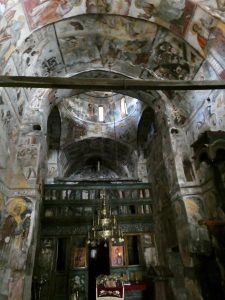

Second, the church frescos really were incredible. Many of the colours were still vivid and because the monastery had undergone a series of renovations, the frescos were varied and even included frescos painted over frescos.
Finally, the views from the monastery were simply amazing. Jane and I ended up climbing over a number of massive rocks to reach a viewing area and boy was it worth it. There were rolling hills and vast farmlands that seemed to run all the way up to the horizon.
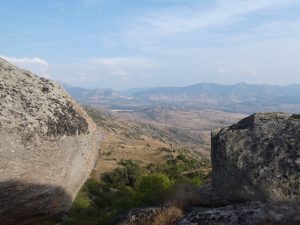
When I had finally had my fill of the views and the frescos, Jane and I climbed back into the van for the ride back down the hill, but not before I jumped out and took a picture of a fresco that was on a rock near the entrance to the monastery.
Anyway, next up was the female monastery of Varosh. We had to drive back into Prilep and then up yet another hill to the monastery entrance. Jane and I got our of the van and started the walk up the hill but were met by a nun who was clearly telling Jane no. Apparently the monastery closes at 5:00 p.m. and while our clock was showing 4:50, the nun advised Jane that the clock in the monastery was showing 5:00 p.m. So rather than a quick look inside, all I saw was a lovely garden and the walls of the monastery. No biggie, but rather odd.

Our final stop of the day was a hike to Marko’s Fortress, named after Serbian medieval Prince Marko Mrnjavčević, The fortress is located on a 120–180 m high hill above Prilep.


Now, I was not sure how long it was going to take me to hike up, but I was hoping for a quick trip. I was exhausted having got very little sleep the night before when some drunken hotel guest rang the door bell to my room not once by twice within a 15 minute span just before midnight. Apparently the idiot couldn’t figure out how to use his key card and he was randomly buzzing doorbells looking for someone to help him out. As a result, it took forever to get to sleep resulting in only about 4 hours of rest. So I was really not looking forward to the hike in the late afternoon sun and heat.
Nevertheless, I was not going to let that stop me so Jane and I began the ascent over a very rocky dirt road. We only passed a single person on the hike up and it was clear this was not a hot spot for tourists. Eventually, the rocky road gave way to sand and lots of grass and ants before turning into a mere path up the hillside.


We finally made it to the top after about 30 minutes, and while the old ruins were pretty cool and the views were spectacular I was ready to turn around and get to the hotel. So after 10 or so minutes at the top, we hiked back down and hopped back in the van for the drive to Krushevo where we would be spending the night. And once in the van, I found out we had walked 22,000 steps today. No wonder I was exhausted! I really was looking forward to some sleep.
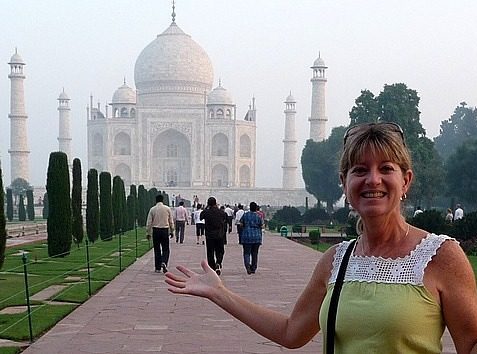
Just really really enjoy your blogs of your trip. So very interesting. Glad to know you are busy about seeing lots of sites
Thanks Sherry. This trip has really been an amazing exploration of local foods and by local, I mean eating with locals and the foods only they can make. Really amazing time.